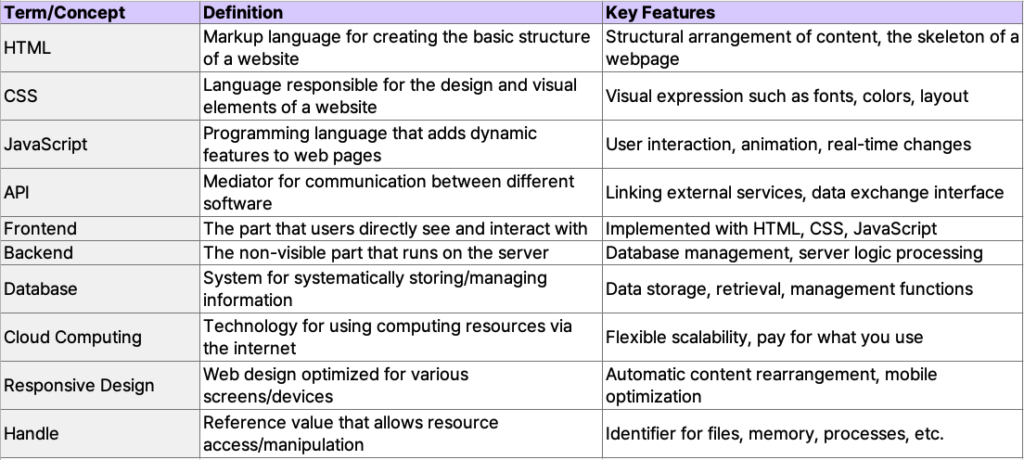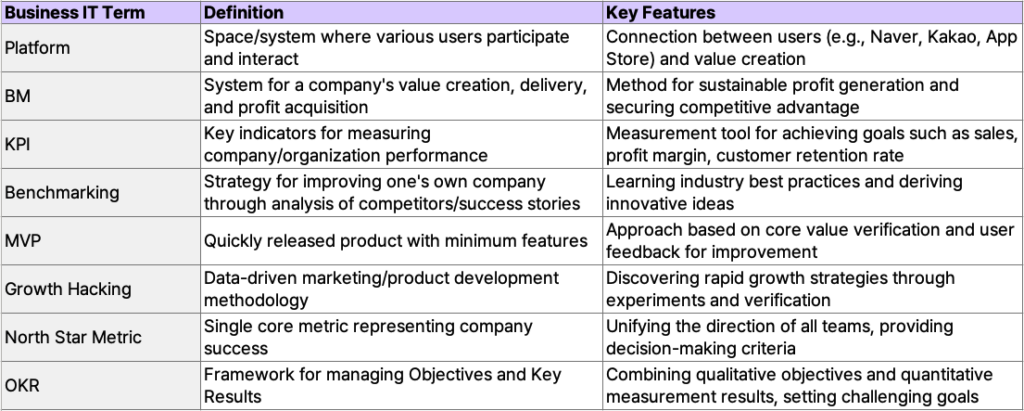Hello, this is BeringLab.
Have you ever felt nervous about an upcoming development meeting — whether it’s with your in-house team or an outsourced partner?
There’s always that fear of not fully understanding the technical jargon used by developers, potentially damaging your company’s credibility or missing critical contractual details.
That’s because IT terminology has become a core component of modern business communication.
As technology evolves rapidly, the scope and depth of IT language grow just as fast.
From foundational computer terms to specialized language in cloud computing, big data, and AI, these terms are now used far beyond just the IT department — they’re essential in marketing, operations, legal, and more.
In this article, we’ll first explore fundamental IT terms commonly used in day-to-day work, then dive into key business-related IT vocabulary.
Lastly, we’ll discuss why accurate translation of IT documents is crucial in global business and what kind of solutions can help you manage this effectively.
✍🏻 Must-Know Basic IT Terms

Essential IT Terminology List
- HTML (HyperText Markup Language): The core language for building the structure of a website.
Used to create the layout of content such as headings, body text, and images. - CSS (Cascading Style Sheets): The language that defines the design and visual elements of a site built with HTML.
It controls fonts, colors, spacing, and layout to give a website its aesthetic appeal and consistency. - JavaScript: A programming language that adds dynamic functionality to websites.
It enables interactive features like animated buttons and content that changes in response to user actions like clicking or scrolling. - API (Application Programming Interface): A mediator that allows different software systems to communicate.
For example, using a weather API to display forecasts, or integrating a payment gateway API to process transactions. - Frontend and Backend: Web development is largely divided into frontend (what users see and interact with) and backend (what happens on the server).
Frontend uses HTML, CSS, and JavaScript, while backend handles logic, data processing, and database management behind the scenes. - Database: A system for organizing and storing data efficiently.
Databases are used to manage user information, content, settings, and more — ensuring data can be accessed and updated as needed.

Key Concepts to Understand
- Cloud Computing: Technology that provides computing resources over the internet without the need for physical servers.
Services like AWS, Azure, and Google Cloud allow companies to scale storage, servers, and networks up or down as needed — reducing upfront costs and increasing flexibility. - Responsive Design: A web design approach that ensures optimal user experience across all devices and screen sizes.
Whether on a smartphone, tablet, or desktop, the content automatically adjusts in layout and scale. It’s now essential, especially for SEO. - Handle: A reference or identifier used to access a specific resource like a file, memory space, or process.
Efficient handle management directly impacts system performance and stability — understanding this concept helps when communicating technical requirements.
✍🏻 Key IT Business Terms

IT Business Terminology List
- Platform: A system or space that facilitates interaction and participation among users.
Examples include Naver, Kakao, or the Apple App Store. Platforms enable connections and create value — forming the backbone of modern digital ecosystems. - BM (Business Model): A framework that explains how a company creates, delivers, and captures value.
A strong business model is crucial for sustainable revenue and competitive advantage. - KPI (Key Performance Indicator): A measurable value that reflects how effectively a company is achieving its goals.
Revenue, profit margin, customer retention, and web traffic can all serve as KPIs for tracking success. - Benchmarking: A strategy that analyzes competitors or best practices to improve a company’s own performance.
It helps businesses learn from top players in the industry and innovate more effectively. - MVP (Minimum Viable Product): The simplest version of a product that still provides core value.
It’s released quickly to gather user feedback and evolve through iterative development rather than building a “perfect” product from the start. - Growth Hacking: A data-driven approach to marketing and product development focused on rapid growth.
Unlike traditional marketing, it emphasizes experimentation and analytics to find scalable strategies for user acquisition and retention.

Critical Concepts to Understand in Business
- North Star Metric: A single, most important metric that reflects the long-term success of a company.
Just like sailors navigate by the North Star, this metric helps align teams around a shared objective.
Facebook, for example, once prioritized “daily active users” as its North Star, ensuring all teams worked toward increasing engagement. - OKRs (Objectives and Key Results): A goal-setting framework that connects goals (what we want to achieve) with key results (how we’ll measure success).
OKRs are typically set quarterly and aim to push teams beyond comfortable targets toward more ambitious outcomes.

These essential IT and business terms are critical for effective communication in today’s digital workplace.
And in global business settings, documents containing these terms often need to be translated into multiple languages.
BeringAI+ solves the challenges of IT document translation by combining advanced AI technology with expert human review.
We leverage cutting-edge machine translation to save time and reduce costs, while our legal and technical professionals ensure more than 99% accuracy.
From technical manuals and product documentation to contracts and patents, BeringAI+ delivers fast, accurate translations that help you move confidently into global markets.
We also offer customized glossaries tailored to each industry, ensuring consistent terminology across all your materials — which helps reinforce your brand and professionalism.
Trusted by over 130 law firms, BeringAI+ is the #1 AI-powered legal translation solution.
Take the first step toward global success without language barriers — get a free quote on the BeringLab website today.

